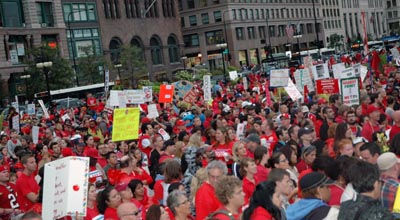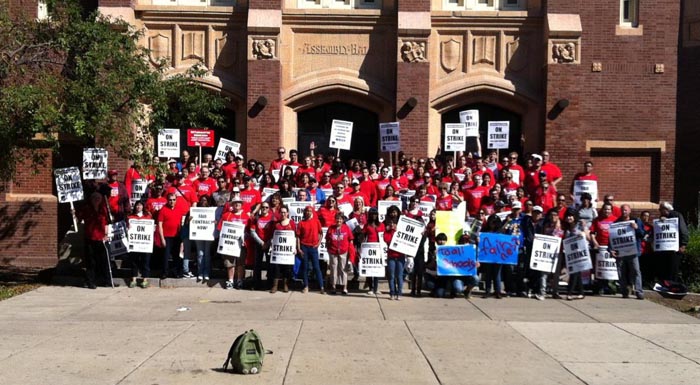 |
Standing Up for Educational Justice: The 2012 Chicago Teachers Union StrikeBy Kurt Hilgendorf
The Chicago Teachers Union's recent strike against the Chicago Public Schools (CPS) was no accident. Rather, the strike was the culmination of a combination of outrage and organizing: teachers, parents, community organizations and students banded together to challenge devastating educational policies in Chicago, the cradle of a nationwide school "reform" effort that has much more to do with breaking unions and doing urban education on the cheap than actually providing low-income African American and Latino students the education they deserve and have been systematically denied for decades. Far from being "the civil rights issue of our time," hedge fund managers, opportunist non-educators and captured policymakers have created a blueprint for privatizing perhaps the most democratic of all public institutions. It was in this environment that CTU members struck for educational and worker justice, and won. What follows is a brief version of this historic event. Rahm Emmanuel was elected mayor of Chicago in February of 2011. His education platform was based on one main talking point (later found to be a complete fabrication): because of the short school day and year, Chicago students were in school almost four fewer years than comparable students in Houston. Emmanuel pledged to end this travesty by forcing Chicago's teachers to work more. Negotiations between Emmanuel's hand-picked school board and the Chicago Teachers Union began in November of 2011. The school board's first offer was a four-year contract that paid teachers a one-time raise of 2% for a longer school day and year that resulted in a 20% increase in work (not including the unpaid out-of-school work that teachers, predominantly women, are expected to do). Throughout the process of negotiations, Chicago's school board and mayor, in conjunction with Astroturf reform groups backed by some of the best-known billionaires in the country, attempted to vilify teachers and school paraprofessionals at every opportunity. For the past 15 years, these groups have been pushing a privatization agenda in large cities that hides behind the language of so-called school reform: measure teachers according to standardized tests, fire experienced teachers and replace them with inexperienced (and therefore cheaper) novices, and open a wave of often for-profit charter schools that give parents a (false) choice. These teacher-bashing efforts were relentless and occasionally bordered on the absurd. The mayor and his allies even went so far as to pay protestors to support policies that fired teachers and threw long-standing community schools, overwhelmingly in African American and Latino neighborhoods, into complete disarray. Despite these challenges, by mid-September 2012 the CTU won a strong contract with major new provisions and protections after a seven day strike in which more than 20,000 teachers walked picket lines every day, parents of CPS students supported teachers 2-to-1 over the mayor, money and support for the CTU flowed in from across the US and countries around the world, and the conversation about education reform in the US was plastered across the front page of almost every major newspaper. Perhaps most importantly, the CTU became a model for how to stand and fight for schools that students deserve. Teachers in Chicago inspired workers around the world. How did a union that as recently as a few years ago caved on almost every reform measure turn into an organization that won a high-profile battle against President Obama's powerful and well-funded former chief-of-staff? Simply put, the Chicago Teachers Union organized and inspired its own members and built broad and deep connections to community and parent organizations across the city. The union transformed itself from a service union struggling to maintain what it had earned decades ago into an organizing union that actively pursues a vision of what public school could be. The current CTU leadership came to office in 2010. As members of the Caucus of Rank and File Educators (CORE), the leadership promised to shake up the union and vowed to defend public education. Officers and other office staff took a pay cut compared to the previous union administration and used the savings to create new research and organizing departments and to expand the communications department. The union's organizers went school by school to develop active union delegates (stewards) and strengthen school-level organization. The research department developed a report called "The Schools Chicago's Students Deserve" to lay out a research-based vision for how different schools would be for the city's predominantly low-income student population if they had art, world language, music, physical education, libraries in elementary schools and sufficient wrap-around services like a reasonable ratio of counselors and social workers for students who suffer from trauma in their daily lives. Union members organized parents to oppose school closings and turnarounds (where the entire staff of a school is fired, including janitors and cafeteria workers) that destroyed their local communities. Even the contract negotiation process widened participation. Rather than just limit the bargaining team to officers and a labor lawyer, the team was expanded to include more than 35 teachers from across the city. In short, a large contingent of rank-and-file teachers was activated to take part in the process of acting like a union. Without this organizational development, the CTU would not have been able to pull off the events that led up to the strike. After almost 6 months of negotiations that had produced little movement, more than 10,000 people rallied and marched for a fair contract at the end of May. Soon after, the union took an historic strike authorization vote. Under Illinois Senate Bill 7, CTU was required to get a vote of 75% of the entire active membership of 26,000 to be able to strike. Anyone who did not vote was automatically counted as a "no" vote. The bill's main backer, Stand for Children's Jonah Edelman, boasted at a 2011 Aspen Institute panel that CTU would never be able to reach that threshold. CTU got more than 90% of members to vote yes; 98% of those who voted said they would strike. Even after those showings, however, the Board would not budge from its negotiating positions. No additional wrap-around staff. No recall policy for experienced educators. The longer day and year that the mayor wanted was still on the table. In July, a fact-finding process mandated by SB7 returned a verdict that overwhelmingly supported CTU, and the American Federation of Teachers (of which CTU is Local 1) passed a resolution at its national convention to stand in support of Chicago's teachers. Still, the Board of Education would not move on the contract. In late August, CTU's House of Delegates authorized the leadership to give 10-day notice of a strike, and on Labor Day, almost 20,000 people turned out for a march and rally that supported CTU's efforts at a fair contract. Finally, after nine months of negotiations that produced insufficient movement, the CTU walked out on September 10th, its first strike in 25 years. The strike was successful because of the support the CTU consciously built with parents and community organizations, the dedication of its members to principles of educational justice, the creativity of teachers' communications (homemade signs, chants, and music videos were amazing), and the union's ability to turn out huge numbers of people. More than 20,000 red-shirted teachers and supporters shut down Chicago's downtown Loop district three out of the strike's first four days. Perhaps more importantly, an equal number of teachers canvassed their school neighborhoods on the strike's fifth day to talk with parents and community members about why the strike was in the best interests of children. CPS finally cracked and made a fair offer that same day. When members of the union's House of Delegates asked for time to digest the tentative agreement and the opportunity to share key tenets with members, democratically choosing to extend the strike for two additional days, commentators fumed that teachers were unnecessarily harming children. However, Chicago residents supported this show of democracy, despite the city's conditioned history of accepting whatever dictate comes from a position of power. The time was valuable, as delegates voted overwhelmingly to end the strike once members had an opportunity to see the terms. The mayor was so damaged by the strike that he commissioned and incessantly ran a TV commercial claiming victory (New York hedge funders picked up the $1 million ad buy tab), and yet parents still back teachers. Clearly, the union's organizing efforts ensured the strike's success. CTU's push for equitable public education did not end with the strike. Emmanuel and CPS have already claimed that their goal is to close 80-120 schools in the near future, push out veteran teachers with the new state-mandated evaluation process, and cut teachers' pensions. CTU will therefore continue to organize and agitate. If you're near Chicago, grab a red shirt and join us — we'll be defending equitable public education at every opportunity.
Kurt Hilgendorf has taught history and coached debate for 6 years in the Chicago Public Schools and is currently on leave from teaching to work for the Chicago Teachers Union.
|



